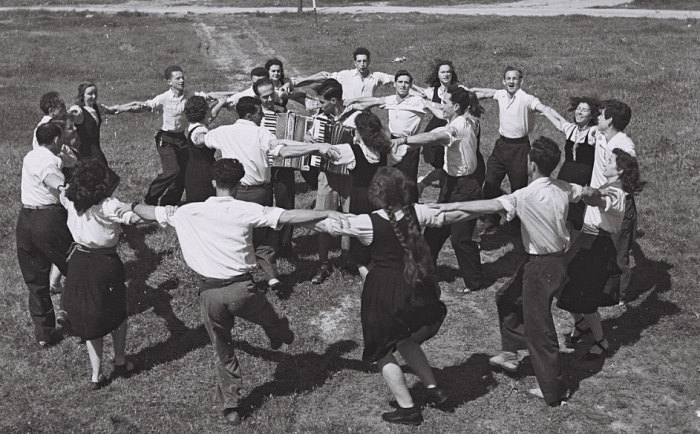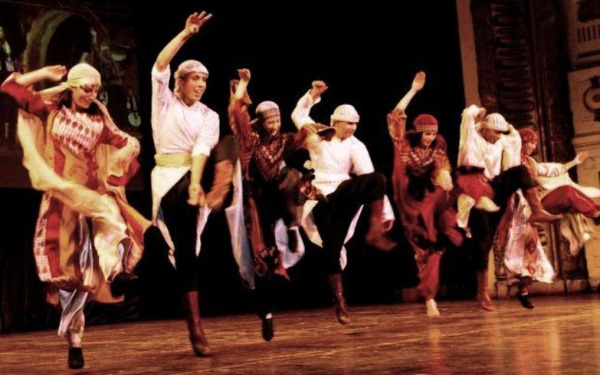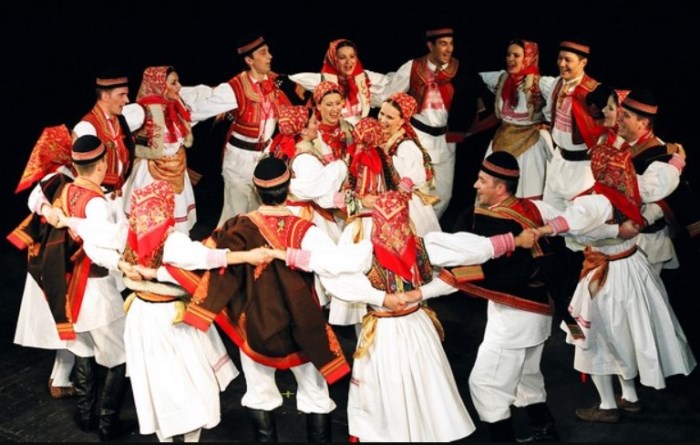Don’t think that just because the circle dance looks simplistic, it’s not a beautiful one!
The circle dance has been around for centuries and is practiced by many communities, societies, and civilizations around the world.
From ancient rituals to modern-day celebrations, this dance form has been used for a long time as a symbol of communal unity and joy, reflected in the circular shape that dancers form into during a performance.
In this article, we will explore the fascinating history and diverse types of circle dance.
Additionally, we’ll also show you a few basic steps and music accompanying this lively dance so that.
By the end of this article, you’ll know all about this wonderful dance form!
Table of Contents
What Is Circle Dance?
The circle dance is exactly what it sounds like.
During a performance, the participants will come together and form a circle. As the music comes on, they’ll move and rock their body to the beat of the music.
The dance can be performed in many different settings, depending on the specific dance and the local traditions (circle dances are typically folk or traditional dances).
However, you’ll only ever find the circle dance being performed at important or joyous events in the community, like weddings, festivals, and religious ceremonies.
Many cultures consider their variation of the circle dance as an integral part of their heritage.
As a result, they take great care to preserve it and pass it down from one generation to another.
Circle Dance Origin & History
The origins of circle dance are shrouded in mystery, but it is believed that it has been practiced for thousands of years.
The true origin is not known, but archaeologists have unearthed petroglyphs (rock carvings) of girls dancing in circles in Egypt.
These artifacts have been dated as far back as 3,000 BC (over 5,000 years ago!)
Besides Ancient Egypt, there have been many records and artifacts of the dance throughout history.
For example, in the 14th century, Giovanni Boccaccio – an Italian poet, and writer – wrote about people dancing in circles while singing and accompanied by musicians.
Just with some cursory diggings, you’ll find examples of the circle dance on virtually all continents, at many different points in time!
Because of the dance’s relative simplicity and natural symbolism (its circular form, a shape revered in many cultures), it’s extremely widespread.
Types of Circle Dances
As we said earlier, there are too many types of circle dances to count from antiquity to today.
Some have been lost to history, some are recorded in documentaries but no longer practiced, while some others are still done today.
So, if you’re looking for inspiration or a recording of what the circle dance may look like, here are a couple of contemporary dances worth checking out.
Balkan Circle Dance and the Hora
The Balkans are one of the places where archaeologists have found evidence of the circle dancing custom in the past.
Gravestones found here (called “Stećci”) were inscribed with images of people dancing in a long chain, with their hands clasped together at shoulder level.
These Stećci have been around since as far back as the 12th century.
The tradition, fortunately, remains. Today in the Balkans, there are still many circle dance forms that you can find people performing.
Most notably: the Hora.

The Hora originally came from the Balkans, but later, they spread to Romania, Moldova, and other countries in inner Europe. It’s also considered a Jewish circle dance in countries like Israel.
In the Hora, the dancers will link their arms with one another and move as one in a circle (usually counter-clockwise).
Each dancer will perform a sequence of steps, involving three steps forward, then one step back … on and on until the music stops.
This dance is very popular and can be seen at joyous events in the community, such as weddings or festivals.
Kolo
The Kolo (Коло in Serbian) is a folk dance that can be found in many Slavic countries, like Serbia and Bosnia.
This is a group dance that can compose of dozens of people.
The dancers will form a circle. Their hands weaved around the waists of the people beside them. Then, they will begin moving and twirling in formation
The peculiar part about the Kolo is that there’s little to no upper-body movement. It’s entirely composed of footwork.
The movements are basic enough that anybody can learn. So, if you ever get the chance to visit these places, don’t hesitate to give them a shot!
Dabke

The Dabke is a very popular circle dance in the Levants (Lebanon, Syria, Palestine, etc.).
In this Muslim circle dance, dancers form into a semi-circle and dance to the rhythm dictated by a leader, called the lawweeh (لويح).
The lawweeh must be an expert dancer, have an impeccable sense of rhythm, and, more importantly, be able to improvise very well.
Besides leading the group, the lawweeh – after the singer has finished his song – may strike out from the group and perform a solo routine, too.
The Dabke is often performed at celebratory events like weddings.
Faroese Chain Dance
The Faroese Chain Dance hails from the Faroe Islands in the North Atlantic (Western Europe).
This dance has been around for centuries, but it was wiped out of existence in mainland Europe due to the church deeming it a pagan tradition.
These days, the dance is only practiced on the Faroes.
Typically, the dance will start in a normal circular formation. But when more people begin to join in, the circle can break apart, swing around, and wobble.
If enough people join, smaller circles can form inside the large one!
The dance involves holding hands while moving in a circular pattern, taking two circle dance steps to the left and one step to the right, without crossing the legs.
Really simple, but when you see it for yourself, it’s oddly beautiful to watch.
Kalamatianos & Syrtos
In the Mediterranean, you can find the Kalamatianos. It’s a Greek folk dance and can be found in many parts of Greece as well as Cyprus.
The dancers hold each other hands as they move in a circular formation, usually counter-clockwise.
The circle of dancers is led by a leader, who will hold onto the second dancer in the line with a handkerchief. This twist allows for many beautiful moves and choreographies to form.
The dance is done on a steady 4/4 beat.
A variation of the Kalamtianos is the Syrtos, in which pairs of dancers link up with one another using handkerchiefs.
Sardana
One of the many highlights of Catalan culture is the Sardana, which is a traditional circle dance.
The dance is performed by a group of people forming a circle, holding hands, and moving to the rhythm of the music.
There are two versions of the dance, the historical version (sardana curta) and the contemporary version (Sardana llaga).
The newer version is much longer than the old one. A performance can stretch over 15 minutes long!
Participants in a dance circle will hold one another’s hands and move in a clockwise direction to the rhythm of the music.
The dance is very simple, involving taking three steps forward, then three steps back. Each person will raise and lower their hands in unison as they do.
Circle Dance Music & Songs
Like most dances out there, music plays a crucial role in circle dances.
In forms of traditional circle dances, the performers are accompanied by live music being played by bands on a mix of modern and traditional instruments.
For example, in the Dabke dance, besides familiar instruments like the lute, there are also more exotic instruments like the tablah (a small hand drum), the mijwiz (a clarinet with two pipes), the daff (a tambourine), etc.
Since circle dances are often folk dances, the music is old songs passed down through generations.
The lyrics will reflect the local culture and people, with a simple structure and even rhythm to facilitate the dance.
Final Words
Though it has been around for centuries, the circle dance still remains in various forms today across continents. It’s also an integral part of many traditional cultures of many people and nations worldwide.
The circular shape of the dance is a beautiful symbol of unity and community.
Found in various popular dances like the Hora and the Dabke, these dances are the perfect opportunity for people living in the same community to connect with their heritage and with one another!
And for visitors, tourists, and scholars, circle dances are also a great way to study and better understand the people of that particular place.





Hi,
I have experienced circle dancing a few times at a Summer camp in Gloucestershire and loved it.
I travel in Europe each year, mainly western Europe, and would love to find places where the local people circle dance and the opportunity to join in. Do you have a list of places or alternative type camps where circle dancing may be on the agenda?
🙏💃